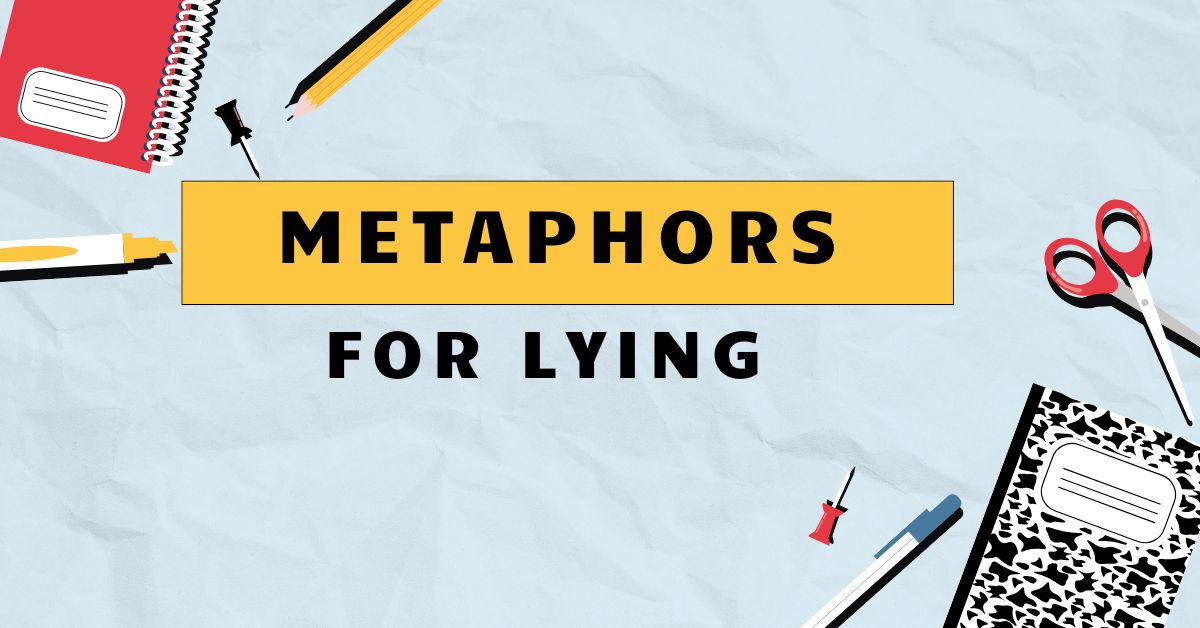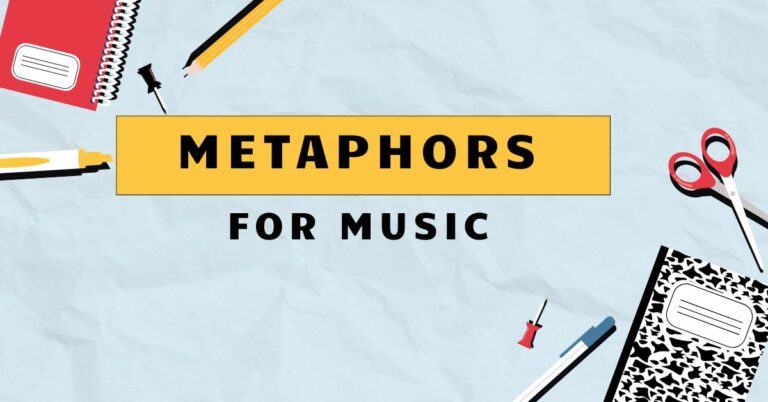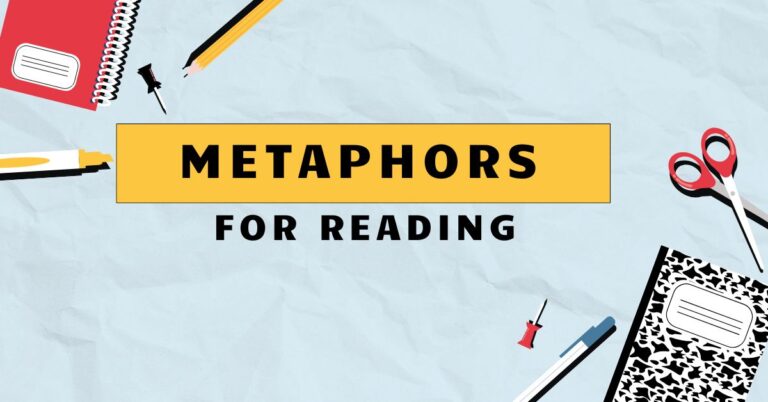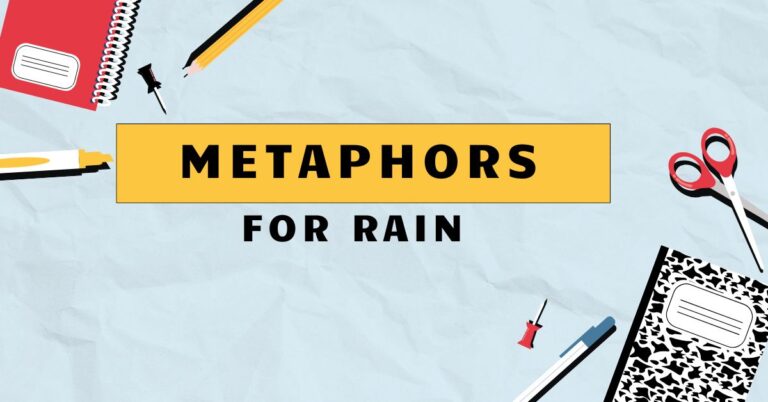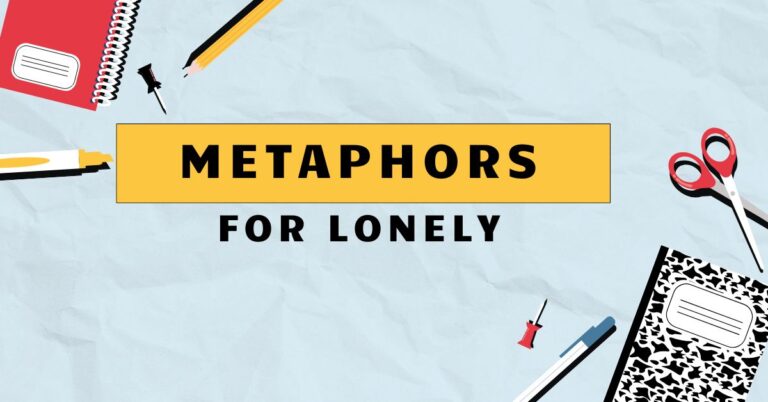45 Metaphors for Lying: Understanding Figurative Language
Understanding metaphors for lying is crucial for comprehending nuanced communication and recognizing deceptive language. This skill enhances our ability to interpret literature, analyze rhetoric, and navigate everyday conversations with greater awareness.
This exploration delves into the various ways lies are figuratively represented, providing insights into how language shapes our perception of truth and deception. This article will benefit students of literature, language enthusiasts, and anyone seeking to improve their critical thinking and communication skills.
Table of Contents
- Introduction
- Definition of Metaphor for Lying
- Structural Breakdown
- Types and Categories of Metaphors for Lying
- Examples of Metaphors for Lying
- Usage Rules
- Common Mistakes
- Practice Exercises
- Advanced Topics
- FAQ
- Conclusion
Definition of Metaphor for Lying
A metaphor for lying is a figure of speech that describes the act of deception by comparing it to something else without using “like” or “as.” It implies a similarity between lying and another concept, often highlighting the nature, consequences, or methods of the deception. These metaphors add depth and emotional resonance to our understanding of dishonesty.
They move beyond literal descriptions, offering a more vivid and impactful way to convey the idea of lying.
The function of metaphors for lying is multifaceted. Primarily, they serve to emphasize the gravity or nature of the lie.
They can also express the speaker’s attitude toward the deception, such as disgust, condemnation, or even amusement. Furthermore, these metaphors can simplify complex ideas, making them more accessible and memorable.
They are used in various contexts, including literature, political discourse, everyday conversation, and legal settings.
Structural Breakdown
A metaphor, in its basic form, consists of two main elements: thetenorand thevehicle. The tenor is the subject being described (in this case, lying), and the vehicle is the object or concept to which the subject is being compared.
The connection between the tenor and the vehicle is the shared characteristic or association that makes the metaphor meaningful.
For example, in the metaphor “His words were a smokescreen,” the tenor is the act of lying or deception, and the vehicle is “smokescreen.” The shared characteristic is the act of concealing or obscuring something. The structure can be further broken down into the following:
- Tenor (Subject): The lie itself, the act of deception.
- Vehicle (Object of Comparison): The image or concept used to represent the lie (e.g., a mask, a web, a shadow).
- Ground (Shared Characteristic): The common attribute that links the lie and the vehicle (e.g., concealment, distortion, fragility).
Understanding this structure helps in analyzing and interpreting metaphors for lying, revealing the underlying meanings and implications of the figurative language.
Types and Categories of Metaphors for Lying
Metaphors for lying can be categorized based on the specific aspect of lying they emphasize. Here are some common categories:
Concealment Metaphors
These metaphors focus on the act of hiding the truth. They often use images of masks, shadows, or veils to represent how lies obscure reality.
Distortion Metaphors
These metaphors highlight how lies twist or alter the truth. They may involve images of mirrors, lenses, or warped perspectives to show how lies create a false image.
Fabrication Metaphors
These metaphors emphasize the creation of something false. They often use images of building, weaving, or crafting to represent how lies are constructed.
Evasion Metaphors
These metaphors focus on the act of avoiding the truth. They might use images of dodging, weaving, or escaping to show how lies are used to avoid direct confrontation with reality.
Superficiality Metaphors
These metaphors highlight the lack of depth or substance in a lie, often comparing it to something shallow or flimsy. They might use images of surfaces, facades, or thin layers to represent the insubstantial nature of a lie.
Examples of Metaphors for Lying
The following tables provides examples of metaphors for lying, categorized according to the types discussed above. Each table contains a variety of examples to illustrate the different ways these metaphors can be used.
Concealment Metaphor Examples
This table illustrates metaphors that equate lying to concealment, hiding, or obscuring the truth. These examples emphasize the deceptive nature of lies by comparing them to things that hide or cover up something else.
| Metaphor | Explanation |
|---|---|
| His lies were a veil over the truth. | The lies hid the truth, like a veil hides a face. |
| The story was a smokescreen. | The story was meant to obscure the real issues. |
| Her words were a mask. | Her words concealed her true feelings or intentions. |
| His alibi was a cover for his actions. | The alibi hid his true whereabouts and activities. |
| The truth was buried under a mountain of lies. | The truth was hidden by many lies. |
| He hid the facts behind a wall of deception. | He actively concealed the truth with lies. |
| Her silence was a cloak for her guilt. | The silence concealed her feelings of guilt. |
| The scandal was swept under the rug. | The scandal was hidden and ignored. |
| The real story was lost in the shadows of misinformation. | The truth was obscured by false information. |
| His explanation was just a whitewash. | His explanation attempted to cover up the truth. |
| The agreement was a facade of unity. | The agreement only appeared to be unified. |
| His promises were a mirage of hope. | His promises created a false sense of hope. |
| The details were shrouded in secrecy. | The details were deliberately kept hidden. |
| His true motives were veiled from everyone. | His real reasons were hidden. |
| The truth remained under wraps. | The truth was kept secret. |
| Her lies were a screen protecting her reputation. | Her lies were used to hide her true character. |
| The evidence was concealed from the public. | The evidence was intentionally hidden. |
| His deception was a shadow over his actions. | His dishonesty tainted everything he did. |
| The truth was masked by layers of deceit. | The truth was hidden by multiple lies. |
| His lies created a darkness around the event. | His lies made the situation unclear and mysterious. |
| The facts were buried deep within the report. | The important information was hidden in the details. |
| Her false identity was a disguise. | Her false identity hid her real identity. |
| His lies were a curtain drawn over the past. | His lies hid the events of the past. |
| The truth was obscured by conflicting reports. | The truth was made unclear by different versions of events. |
Distortion Metaphor Examples
This table presents metaphors that describe lying as a form of distortion, twisting, or misrepresenting the truth. These metaphors use imagery that suggests a change or alteration of reality.
| Metaphor | Explanation |
|---|---|
| His words were a twisted version of the truth. | His words presented a distorted view of reality. |
| The facts were bent to fit his narrative. | The facts were altered to support his story. |
| Her story was a funhouse mirror. | Her story presented a distorted and exaggerated view. |
| His perspective was a warped view of reality. | His understanding was skewed and inaccurate. |
| The report was a caricature of the truth. | The report exaggerated and distorted the facts. |
| His lies were a prism, refracting the truth into many colors. | His lies broke the truth into different, altered versions. |
| The evidence was manipulated to support his claim. | The evidence was altered to fit his argument. |
| His account was a skewed representation of events. | His version was biased and inaccurate. |
| The information was filtered to create a false impression. | The information was selectively presented to deceive. |
| His lies were a lens that distorted reality. | His lies changed the way people perceived the truth. |
| The situation was painted in a false light. | The situation was presented deceptively. |
| His story was a mosaic of half-truths. | His story was made up of partly true and partly false information. |
| The facts were rearranged to mislead the audience. | The facts were presented in a misleading order. |
| His words were a fabrication, spun from thin air. | His words were completely made up. |
| The narrative was crafted to deceive the public. | The story was carefully constructed to mislead people. |
| His lies were a contortion of the truth. | His lies twisted and distorted the reality. |
| The reality was stretched beyond recognition. | The truth was exaggerated to an unrecognizable extent. |
| His deception was a blurring of the lines between fact and fiction. | His dishonesty made it hard to distinguish between what was real and what was not. |
| The truth was muddled by conflicting accounts. | The truth was made unclear by different and contradictory stories. |
| His lies were a deceptive angle on the situation. | His lies presented a misleading perspective on the event. |
| The story was colored with falsehoods. | The story was influenced by lies. |
| His report was a perversion of the original intent. | His report distorted the original purpose. |
| The facts were reshaped to fit his agenda. | The facts were altered to suit his plans. |
| His lies created a false image of himself. | His lies gave a misleading impression of his character. |
Fabrication Metaphor Examples
This table includes metaphors that liken lying to the act of creating or building something entirely false. These examples highlight the active construction of a lie.
| Metaphor | Explanation |
|---|---|
| His story was a web of lies. | His story was intricately woven with falsehoods. |
| He built his reputation on a foundation of lies. | His good image was based on false pretenses. |
| Her testimony was a house of cards. | Her testimony was fragile and easily collapsed. |
| His excuse was a patchwork of half-truths. | His excuse was made up of partly true and partly false information. |
| The scandal was a carefully constructed deception. | The scandal was meticulously planned and executed to deceive. |
| His alibi was manufactured to protect him. | His alibi was fabricated to shield him from blame. |
| Her story was a tapestry of deceit. | Her story was elaborately woven with lies. |
| His explanation was a fiction presented as fact. | His explanation was a made-up story treated as truth. |
| The report was a fabrication from start to finish. | The report was entirely false. |
| His lies were a castle in the sky. | His lies were unrealistic and unsustainable. |
| The evidence was planted to frame him. | The evidence was falsely created to incriminate him. |
| His story was a work of fiction. | His story was completely made up. |
| The claim was a complete invention. | The claim was entirely fabricated. |
| His lies were a carefully crafted narrative. | His lies were skillfully constructed to deceive. |
| The scandal was a plot to undermine his authority. | The scandal was a planned scheme to weaken his power. |
| His account was a concoction of lies. | His account was a mixture of fabricated stories. |
| The evidence was falsified to mislead the jury. | The evidence was altered to deceive the court. |
| His version of events was a pure invention. | His story was entirely made up. |
| The rumor was a creation of malicious gossip. | The rumor was invented to spread negativity. |
| His lies were a fantasy he tried to make real. | His lies were a made-up world he attempted to bring to life. |
| The story was contrived to gain sympathy. | The story was artificially created to evoke pity. |
| His testimony was a deliberate construct of falsehoods. | His testimony was intentionally built on lies. |
| The report was a synthetic version of the truth. | The report was artificially created and not genuine. |
| His lies were a theater of deception. | His lies were a performance designed to deceive. |
Evasion Metaphor Examples
This table provides metaphors where lying is portrayed as evasion, dodging, or avoiding the truth. These examples emphasize the act of steering clear of direct honesty.
| Metaphor | Explanation |
|---|---|
| He danced around the truth. | He avoided answering directly. |
| She skirted the issue. | She avoided addressing the topic directly. |
| He dodged the question. | He avoided answering the question. |
| They beat around the bush. | They avoided getting to the point. |
| He side-stepped the inquiry. | He avoided the question by changing the subject. |
| His answer was a zig-zag away from the truth. | His answer indirectly avoided the real facts. |
| She finessed the details to avoid blame. | She skillfully avoided taking responsibility. |
| He steered clear of the sensitive topic. | He avoided discussing the difficult subject. |
| His response was an escape route from accountability. | His response was designed to avoid responsibility. |
| He evaded the direct question. | He avoided answering the question straight forward. |
| Her answer was a detour around the truth. | Her answer took a roundabout route to avoid the real issue. |
| He hedged his bets with vague statements. | He avoided commitment with unclear remarks. |
| She played it safe by not revealing everything. | She avoided risk by withholding information. |
| He maneuvered his way out of the conversation. | He skillfully avoided further discussion. |
| His silence was a retreat from the issue. | His silence was a way of avoiding the problem. |
| She bypassed the difficult questions. | She avoided the hard questions. |
| He ducked the responsibility. | He avoided taking responsibility. |
| Her response was a swerve to avoid the truth. | Her answer was a sudden change in direction to avoid honesty. |
| He slipped away from the confrontation. | He quietly avoided the conflict. |
| Her explanation was a long and winding road away from the truth. | Her explanation was indirect and avoided the main point. |
| He weaved through the conversation without answering. | He skillfully avoided giving a direct answer. |
| His response was a tangent to avoid the subject. | His response was a diversion from the main topic. |
| She eluded the question with a smile. | She avoided the question with charm. |
| He sidestepped the blame. | He avoided being blamed. |
Superficiality Metaphor Examples
This table features metaphors that describe lies as superficial, lacking depth, or being flimsy. These examples emphasize the insubstantial nature of lies.
| Metaphor | Explanation |
|---|---|
| His promises were empty words. | His promises lacked sincerity and substance. |
| Her apology was shallow and insincere. | Her apology lacked depth and genuine remorse. |
| His explanation was thin and unconvincing. | His explanation lacked detail and was not believable. |
| Her story was a veneer of respectability. | Her story only appeared respectable on the surface. |
| His charm was just a gloss over his true nature. | His charm was a superficial layer hiding his real character. |
| The agreement was a paper-thin promise. | The agreement was weak and easily broken. |
| His sincerity was a surface act. | His sincerity was not genuine. |
| Her words were a facade of concern. | Her words only appeared to show concern. |
| His story was a mere pretense. | His story was just an outward show. |
| Her smile was a mask of happiness. | Her smile hid her true feelings. |
| His confidence was a sham. | His confidence was fake. |
| The progress was only cosmetic. | The progress was superficial and did not address underlying issues. |
| His argument was hollow and without substance. | His argument lacked depth and meaning. |
| Her words were fleeting and insincere. | Her words were temporary and not genuine. |
| His performance was skin-deep. | His performance lacked true emotion. |
| Her explanation was a superficial account. | Her explanation lacked depth and detail. |
| His support was a token gesture. | His support was minimal and insincere. |
| Her concern was a show for the cameras. | Her concern was only for public appearance. |
| His apology was just lip service. | His apology was insincere and without action. |
| The solution was only a quick fix. | The solution was temporary and did not address the root cause. |
| His words were as fragile as glass. | His words were easily broken or disproven. |
| Her kindness was a thin layer over her true intentions. | Her kindness was a superficial cover for her real motives. |
| His promises were ephemeral and quickly forgotten. | His promises were short-lived and meaningless. |
| The agreement was a flimsy arrangement. | The agreement was weak and easily broken. |
Usage Rules
When using metaphors for lying, it’s essential to consider the context and audience. The metaphor should be appropriate for the situation and easily understood by the intended recipients.
Overusing metaphors can make your language seem contrived or confusing, so use them judiciously.
- Clarity: Ensure the metaphor is clear and its meaning is easily discernible. Avoid obscure or overly complex metaphors that might confuse the audience.
- Relevance: The metaphor should be relevant to the context and the specific type of lying being described.
- Consistency: Maintain consistency in the metaphor throughout the discussion. Avoid mixing metaphors that can create a confusing or contradictory image.
- Audience: Consider your audience’s background and understanding when choosing a metaphor. What resonates with one group may not resonate with another.
- Tone: Be mindful of the tone you want to convey. Some metaphors can be humorous, while others can be serious or critical. Choose a metaphor that aligns with your intended tone.
It’s also important to be aware of cultural differences. Metaphors that are common in one culture may not be understood or appreciated in another.
Always consider the cultural context when using figurative language.
Common Mistakes
One common mistake is usingmixed metaphors, which combine two or more unrelated metaphors, creating a confusing or nonsensical image. For example, “He was skating on thin ice while building bridges” combines the metaphor of being in a precarious situation (skating on thin ice) with the metaphor of establishing connections (building bridges).
This creates a contradictory and confusing image.
Another mistake is usingclichéd metaphors, which are overused and lack originality. For example, saying “His lies were a drop in the ocean” is a cliché that doesn’t add much impact or insight.
Strive for fresh, original metaphors that capture the essence of lying in a unique and memorable way.
Here’s a table illustrating some common mistakes with metaphors for lying:
| Incorrect | Correct | Explanation |
|---|---|---|
| He was skating on thin ice while building bridges with his lies. | He was skating on thin ice with his lies. | Avoid mixing metaphors. |
| His lies were a drop in the ocean. | His lies were a flood eroding trust. | Use original, impactful metaphors instead of clichés. |
| The truth was a needle in a haystack of lies, soaring through the roof. | The truth was a needle in a haystack of lies. | Ensure the metaphor is logical and coherent. |
| His lies were a brick wall, but also a house of cards. | His lies were a house of cards. | Avoid contradictory metaphors. |
Practice Exercises
Test your understanding of metaphors for lying with these exercises. Choose the best metaphor to complete each sentence.
Exercise 1: Identify the metaphor in each sentence and explain its meaning.
| Question | Answer |
|---|---|
| 1. His alibi was a carefully constructed _____. | His alibi was a carefully constructed web. The metaphor suggests that his alibi was intricate and deceptive. |
| 2. The truth was buried under a _____ of lies. | The truth was buried under a mountain of lies. The metaphor implies that the truth was hidden by a large quantity of lies. |
| 3. Her words were a _____ concealing her true intentions. | Her words were a mask concealing her true intentions. The metaphor suggests that her words hid her real feelings and motives. |
| 4. His explanation was a _____ of the truth. | His explanation was a distortion of the truth. The metaphor indicates that his explanation twisted and misrepresented the facts. |
| 5. He _____ around the question, avoiding a direct answer. | He danced around the question, avoiding a direct answer. The metaphor suggests that he skillfully avoided answering the question directly. |
| 6. The scandal was _____ under the rug, never to be spoken of again. | The scandal was swept under the rug, never to be spoken of again. The metaphor implies that the scandal was hidden and suppressed. |
| 7. His promises were just _____ words, lacking any real commitment. | His promises were just empty words, lacking any real commitment. The metaphor suggests that his promises were insincere and meaningless. |
| 8. Her kindness was a _____ over her true intentions. | Her kindness was a veneer over her true intentions. The metaphor indicates that her kindness was superficial and concealed her real motives. |
| 9. The facts were _____ to fit his agenda. | The facts were bent to fit his agenda. The metaphor suggests that the facts were altered to support his plans. |
| 10. His lies were a _____ in the sky, unrealistic and unsustainable. | His lies were a castle in the sky, unrealistic and unsustainable. The metaphor implies that his lies were fanciful and impossible to maintain. |
Exercise 2: Rewrite the following sentences using metaphors for lying.
| Question | Answer |
|---|---|
| 1. He was not telling the truth. | His words were a smokescreen, obscuring the truth. |
| 2. She hid the facts from everyone. | She veiled the facts in secrecy, keeping them hidden from all. |
| 3. His story was completely made up. | His story was a complete fabrication, spun from thin air. |
| 4. They avoided answering the question directly. | They danced around the question, never giving a straight answer. |
| 5. Her apology was insincere. | Her apology was a shallow gesture, lacking genuine remorse. |
| 6. He twisted the truth to suit his own purposes. | He bent the truth to fit his narrative, distorting reality. |
| 7. The evidence was falsified to mislead the jury. | The evidence was planted, a deliberate deception to mislead the jury. |
| 8. She evaded the question with a smile. | She eluded the question with a smile, gracefully avoiding the truth. |
| 9. His promises were meaningless. | His promises were empty words, devoid of substance. |
| 10. The scandal was hidden from the public eye. | The scandal was swept under the rug, concealed from public scrutiny. |
Advanced Topics
At an advanced level, the study of metaphors for lying can delve into the psychological and sociological implications of deceptive language. This includes analyzing how metaphors shape public opinion, influence political discourse, and perpetuate stereotypes.
Advanced learners can also explore the use of metaphors in literature and film to create complex characters and narratives centered around deception.
Furthermore, the study of cognitive linguistics provides insights into how metaphors are processed and understood in the brain. This field examines the relationship between language, thought, and perception, offering a deeper understanding of how metaphors influence our cognitive processes.
Another advanced topic is the cross-cultural analysis of metaphors for lying. This involves comparing how different cultures conceptualize and express deception through figurative language.
Such analysis can reveal valuable insights into cultural values, beliefs, and attitudes toward honesty and dishonesty.
FAQ
- What is the difference between a metaphor and a simile?
A metaphor directly equates two things, while a simile compares them using “like” or “as.” For example, “His lies were a web” is a metaphor, while “His lies were like a web” is a simile. Similes make an explicit comparison, while metaphors imply a connection.
- Why are metaphors for lying important?
Metaphors for lying add depth and emotional resonance to our understanding of deception. They help us grasp the nature and consequences of lying in a more vivid and impactful way. They also reveal the speaker’s attitude toward the deception and simplify complex ideas.
- How can I identify a metaphor for lying?
Look for statements that describe lying in terms of something else without using “like” or “as.” The statement should imply a similarity between lying and another concept, such as concealment, distortion, or fabrication. Consider the context and overall meaning of the statement.
- What are some common categories of metaphors for lying?
Common categories include concealment metaphors (e.g., “His lies were a mask”), distortion metaphors (e.g., “His words were a twisted version of the truth”), fabrication metaphors (e.g., “His story was a web of
lies”), evasion metaphors (e.g., “He danced around the truth”), and superficiality metaphors (e.g., “His promises were empty words”).
- How can I improve my use of metaphors for lying?
Practice using metaphors in your writing and speaking. Pay attention to how others use metaphors and analyze their effectiveness. Be mindful of clarity, relevance, consistency, audience, and tone. Avoid mixed metaphors and clichés. Strive for originality and impact.
Conclusion
Metaphors for lying provide a powerful and nuanced way to understand and communicate about deception. By exploring the different types and categories of these metaphors, we can gain a deeper appreciation for the complexities of language and the ways in which it shapes our perception of truth and falsehood.
Whether you are a student of literature, a language enthusiast, or simply someone seeking to improve your communication skills, mastering the art of using and interpreting metaphors for lying can enhance your critical thinking and analytical abilities.

